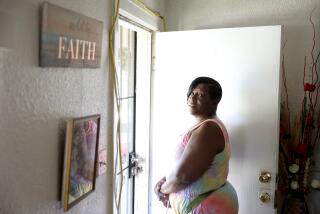Armor for the Real World
- Share via
Their schooling is spotty, their job training is minimal, their life skills usually are nonexistent. Then there’s the emotional damage from years of abuse or neglect. So when the children who grow up in foster care are cut loose at 18, why are we surprised when they end up sleeping in parks or in jail?
Each year 2,300 California kids “age out” of foster care. The counties that cared for them, because their parents couldn’t or wouldn’t, often give these teenagers little more than a new toothbrush and clean socks before releasing them. Times photographer Gail Fisher and writer Phil Willon followed three Orange County teens during their first year on their own. In that time, Janea Barton bumbled into an abusive marriage, lived on the streets and became pregnant; Jesse Equihua landed in jail three months after he left his group home, and Monique Luna, who began her first year of legal adulthood with one daughter, ended it pregnant with a second.
Their stories are all too typical. A high proportion of the 20,000 young people nationwide who leave foster care every year is already lagging in school and struggling with substance abuse and violence. About 40% end up on welfare, and an equal number fail to graduate from high school. Within two years, 18% of these teens have spent time behind bars and one-third have children, most out of wedlock.
What would improve these odds?
For starters, meaningful planning. State law requires social workers to begin charting a course for emancipation once a child reaches 16. These plans are supposed to be a road map to help the teens choose a college and unearth scholarship money, find a job or trade school and connect with housing and transportation. Such plans in the past were often cobbled together as the foster child was exiting.
Until recently, most of the exiting teenagers in Los Angeles had no plan at all, and the county Department of Children and Family Services risked forfeiting millions in state and federal money intended to help with the difficult transition. To make sure that didn’t happen, the department spent madly last June at the end of the fiscal year, handing out gift certificates for clothing and computers to foster kids as they left. Not long afterward, the Board of Supervisors directed David Janssen, the county’s chief administrative officer, to oversee emancipation planning by the children’s services department. Sharon Watson, whom Janssen hired to lead this effort, now has a blueprint for reform and seems to have the resolve to do what Anita Bock, head of children’s services, could not.
Orange County, with many fewer children in foster care, is now moving beyond Los Angeles in creating mentoring programs at Cal State Fullerton and UC Irvine for former foster-care teens enrolled there.
Housing is also critical. Teens leaving foster care, like those leaving their parents’ homes for college, need independence--but they still need boundaries to keep them out of trouble and off the streets. Halfway houses for emancipating foster-care kids and those released from probation camps have adults on site. They bar drug and alcohol use and usually require that residents work or attend school, share household chores and obey a curfew. But there aren’t nearly enough of these homes. Orange County has places for just 80 of the 250 young people who leave foster care annually. Los Angeles County manages close to 600 beds but needs about 2,300.
The violence, homelessness, pregnancies and jail time that derailed Janea, Monique and Jesse are measures of how much more each county must do to help the troubled children it raises become productive adults.
More to Read
Sign up for Essential California
The most important California stories and recommendations in your inbox every morning.
You may occasionally receive promotional content from the Los Angeles Times.













